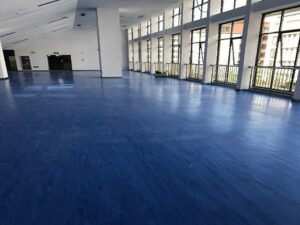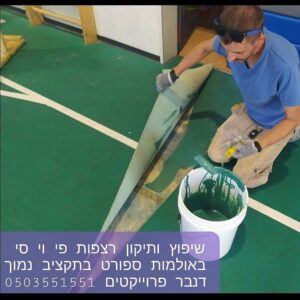Specifications for performing a flexible anti-slip coating
Specifications for performing a flexible anti-slip coating
Renewal of PVC coated floors with flexible anti-slip polyurethane

Flexible anti-slip coating specification for coated concrete floor www.denber.net

Flexible anti-slip coating specification for coated concrete floor www.denber.net
introduction:
An abrasion-resistant and UV-resistant coating performance system is required. Rugged and flexible for heavy foot traffic. The coating will be done after peeling off the PVC and thorough cleaning. Proper treatment of cracks and expansion joints. The coating will be smooth and rough. And the appropriate coating is a multi-thick monolithic polyurethane UV-resistant coating. On a 2 mm thick penetrating primer layer . For abrasion resistance and a rough upper UV protection layer to prevent slipping. The casting layer of 2 mm and/or more will be done in one thick casting.
Area preparation:
- Removing the PVC coating, removing the glue by melting with a thinner for softening and peeling and/or diamond polishing in a deep vacuum until you get a clean and white concrete surface free of pollutants.
- The allowed concrete moisture is less than 4% test with a moisture meter with pins that penetrate the concrete.
- If there is grease penetration into the concrete – spreading an emulsifier into N oil “for absorbing the grease” and washing with water until foam stops coming out. After complete drying (moisture less than 4% test with a hygrometer with pins penetrating the concrete) – additional light polishing.
- Expansion seams – removal of any other existing previous sealing. Diamond polishing on both sides of the seam and polishing the edges of the seam includes penetration into the seam to a depth of up to twice the width of the seam. Strict vacuum suction.
Polishing and vacuuming:
- until you get a white and clean surface.
- Thorough vacuuming and dust removal.
- During polishing, the machine must be connected to a vacuum system, and the polishing worker must wear protective glasses, earplugs and a dust mask. High-quality polishing of all concrete surfaces is required until a white (very bright) concrete is obtained. Strict vacuum suction.
Primer layer:
- Mix part A + part B well with an electric stirrer until you get a uniform solution.
- Applying a layer of epoxy flour primer 1 liter per 5 square meters of concrete. 200 microns thick. Can be applied with a roller/squeegee. For damp concrete – epoxy flour primer 450
Renewal of PVC coated floors with flexible anti-slip polyurethane
Pouring grout and filling expansion seams:
- If there are “bald areas” in the floor/large holes, height differences must be filled with a three-component epoxy grout (base+hardener+filling aggregate of various sizes).
- Deep diamond polishing should be performed in holes/bald areas until white and clean concrete is obtained (pump and apply epoxy flour primer before applying the grout).
- Preparation of grout mixture: mix part A + part B and while mixing add mixed quartz into the bucket until you get a thick mixture like concrete.
- The mixture should be poured immediately into the clearings/holes and leveled two and a half times with grout until full compaction is obtained and leveled to “zero” height. 24 hours drying at least.
- Expansion seams – for large and deep seams where there is a chance of the sealant leaking to the floor below, the root of the seam must be sealed with polyurethane gum (let it dry for at least 3 hours) or, alternatively, compress a suitable backing profile so that there remains a depth to fill with sealant at least the width of the seam. The rest of the seam volume up to “zero” height must be filled with Polyplex 225 two-component putty with the addition of Aerosil/Cabosil for qualification until a thick and comfortable mixture is obtained. With leveled expansion seams, you can work with no qualification at all or only a slight qualification. For narrow seams – you can fill directly with a well-certified polyplex 225 putty, without a backup profile or gum at the root of the seam. 24 hours drying at least.
Casting Polyplex Fluor 225 A 100% solids, flexible polyurethane:
- The casting can be done 4-24 hours after applying the primer (if no grout is required in the area for leveling) or 24 hours after filling expansion seams and grout. It is recommended after 4 hours to check the stickiness of the primer and if it is dry enough to walk on, it is recommended to start casting. The optimal time point to start casting is the moment when, by pressing hard, there is no fingerprint left on the primer. Waiting more than 24 hours may bring the primer to too high a hardness and such a surface tension that it will reject the top coating layer. Then it is necessary to soften the surface with MEK and if it has been 3 days or more, another new primer layer is required which after about 4 hours you can start casting.
- Another primer layer after the grout is always recommended and will ensure the final closure of open “purims” in the concrete that were not finally closed with the first primer layer. Something that will prevent the phenomenon of bubbles resulting from gases emitted from completely unsealed concrete. Wait for drying 4 hours or fingerprint test and start pouring.
Renewal of PVC coated floors with flexible anti-slip polyurethane
- The casting – before starting the casting, make sure that the humidity in the air is lower than allowed relative to the ambient temperature on the day of the casting. (See table for optimal castings of polyurethane coatings)
- Mix Polyplex Fluor 225A part A 15 liters + part B 5 liters (ratio 3:1) and together 20 liters. You can add up to a third of the mixture (another 6-7 liters) quartz flour or fine quartz 0.1-0.3 and provided that its humidity is lower than 4% (check and verify with a suitable spike moisture meter)
- Transfer the mixture to a clean container and mix again – mandatory. The whole mixing process takes no more than 10 minutes so that the material does not heat up and spoil.
- Immediately pour the entire mixture along the wall/border. From the corner of the area to be coated and level with a toothed ruler to the required thickness (at least 2 mm). Add and continue pouring sections until the completion of about 2 meters of pouring strip from the wall.
- Go with a spiked roller to remove bubbles on the cast surface.
- Continue casting another area. And again with the spiked roller. And so on until the end of the entire casting. Be sure to work quickly and intensively without breaks to maintain the casting sequence until the end.
Anti-slip roughness layer:
- After 12-24 hours and provided that the casting has dried. Prepare a polyplex 225A mix with the desired size abrasive aggregate for roughing. (A size up to 1.2 mm and no more is recommended. So that it does not stick out so that with light blows or tire wear the aggregate will be pulled out of the coating)
- Apply the mixture to the surface with a short hair epoxy roller. For a uniform roughness without “baldness”.
- Alternatively, you can apply a 5 mm layer of polyplex 225A and spread the quartz manually over it uniformly.
- Or alternatively, for a delicate and decorative roughness, a layer of Dunbargloss Antislip

Dunbargloss UV protection layer in the shade of the casting:
- After 4-24 hours drying of the rough polyplex 225A layer. Apply with a roller one layer of at least 100 microns dry or spray with airless. 2 layers of Dunbargloss Flor, a variety of color, at least 50 microns dry, or one of 100 microns.
Renewal of PVC coated floors with flexible anti-slip polyurethane
warning:
- Coating on new concrete only after at least one month to ensure completion of the curing process.
- On damp concrete – if it cannot be dried to the required level. (Due to lack of time, natural environmental humidity, it is forbidden to dry with a gas dog for safety reasons). Apply a coat of epoxy primer 450 only.
bill of quantities:
Area: 2500 square meters
- Epoxydan Fluor primer transparent penetrating: 500 liters = 28 buckets 18 liters
- Polyplex 225A – 1.32 liters for casting + 0.5 liters for roughing = 1.82 liters per square meter (2 liters) x 2500 = 5,000 liters = 278 buckets 18 liters
- Quartz flour or quartz 0.1-0.3, 1.2 kg x 2500 = 3 tons = 120 bags 0.1-0.3
- Grinding aggregate 0.8-1.2 mm – 2.5 tons = 100 bags
- Danbergloss Flour – 33 15 liter buckets
We will be happy to be at your service with advice and telephone support:

 English
English עברית
עברית Русский
Русский